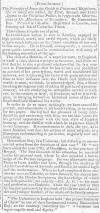Masthead

Column 1

Column 2

Column 3

Column 4

Column 5

Column 6
Raja Rammohun Roy "stands in history as a bridge over which India marches from her unmeasured past to her incalculable future. He was the arch which spanned the gulf that yawned between superstition and science, between despotism and democracy, between immobile custom and a conservative progress, between a bewildering polytheism and a pure, if vague, theism" [Sophia Dobson Collet, The Life and Letters of Raja Rammohun Roy, ed. Hem Chandra Sarkar, rev. ed. (Calcutta: A. C. Sarkar, 1913)].
Born in the village of Radhanagar, Hooghly District of Bengal, May 22, 1772, Rammohun Roy, became one of India's most talented linguists, philosophers, and social and religious reformers. He learned Arabic, Persian, Sanskrit, English, Greek, Latin, and Hebrew. From 1803 to 1814, he was an employee of The East India Company.
Rammohun Roy's study of Christian and Islamic theology helped to convince him of the value of monotheism. In addition to these studies along with all of the ancient Indian religious texts--including the Upanishads and the Bhagavad Gita--he was an admirer of the ethical teachings of Jesus. In 1822 however, Joshua Marshman, Carey's colleague and member of the "Serampore Trio," published A Defence of the Deity and Atonement of Jesus Christ, in reply to Ram-mohun Roy of Calcutta (London: Kingsbury, Parbury, and Allen, 1822). Despite his theological disagreement with Marshman, Rammohun Roy supported the introduction of Western civilization (i.e. science, technology, education) into India.
A review of Roy's life, book The Precepts of Jesus the Guide to Peace and Happiness, and Joshua Marshman's response appeared in the London Literary Gazette and was reprinted in the National Gazette and Literary Register (Philadelphia, Pennsylvania, Saturday August 27, 1831). To review this article, click on the following links:
|
Masthead |
 Column 1 |
 Column 2 |
 Column 3 |
 Column 4 |
 Column 5 |
 Column 6 |
As the founder of the theistic society Brahma Samaj (i.e. Society of Brahma) in 1828, Rammohun Roy worked for reform of the traditional caste system and the improvement of the social status of women and children. Rammohun Roy played a key role in advocating women's rights, including education, property, and widow re-marriage. He opposed polygamy, female servitude, and suttee (literally translated as "good woman"), more commonly known as "widow burning." The significance of his role--along with his friend William Carey--in relation to suttee helped to effect the abolishment of the practice in 1829 by the British Governor General of India, William Bentinck. In 1830, Rammohun Roy became the envoy of the Emperor of Delhi to England, and on September 27, 1833, Rammohun Roy died in England.
To view the Indian stamp and first day brochure that honors Raja Rammohun Roy, click on the links below:
Brochure Front Cover Brochure, p. 1 Brochure, p. 2
Brochure, p. 3 Brochure, p. 4 Brochure Back Cover
Created: May 22, 2001 Updated: July 24, 2006